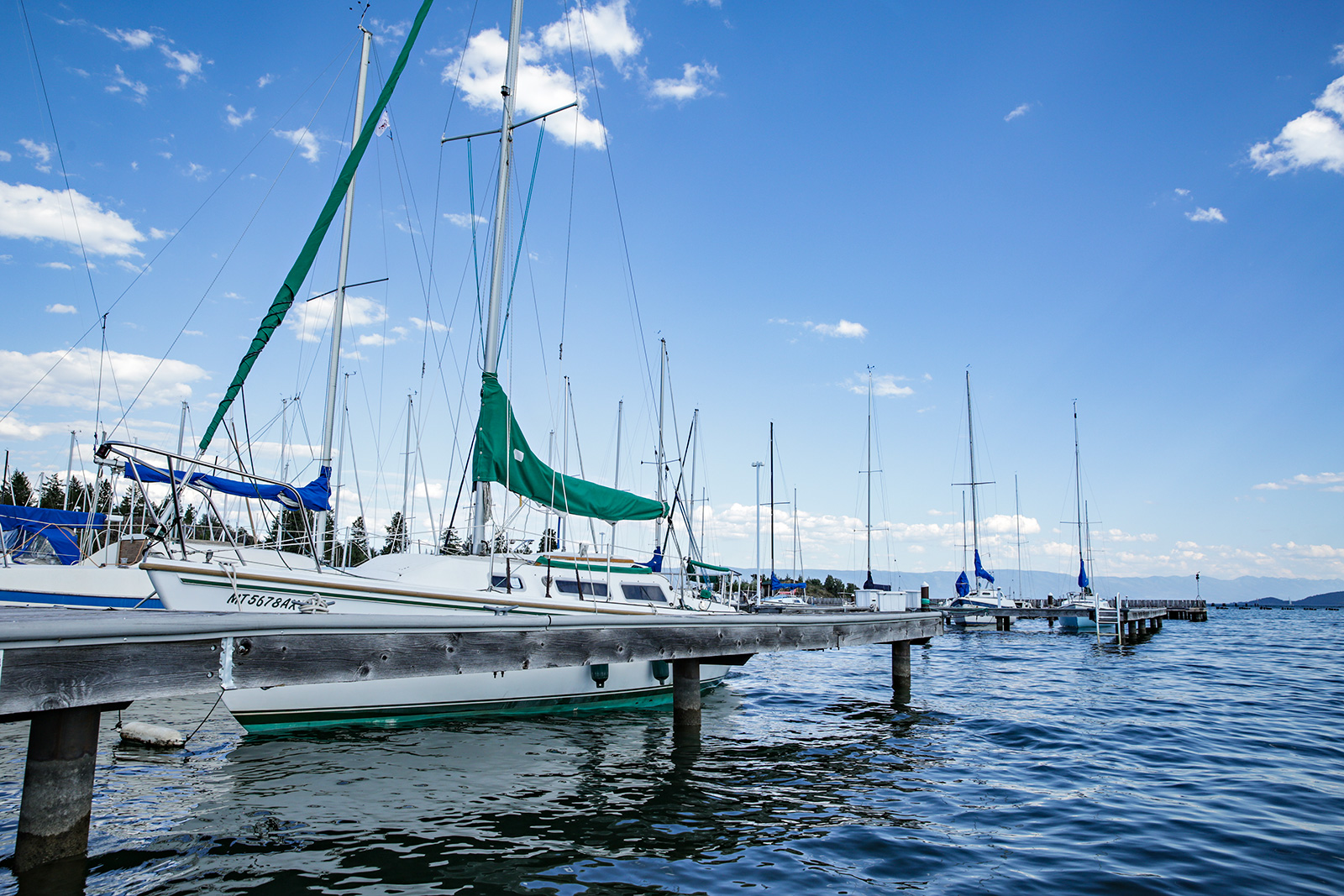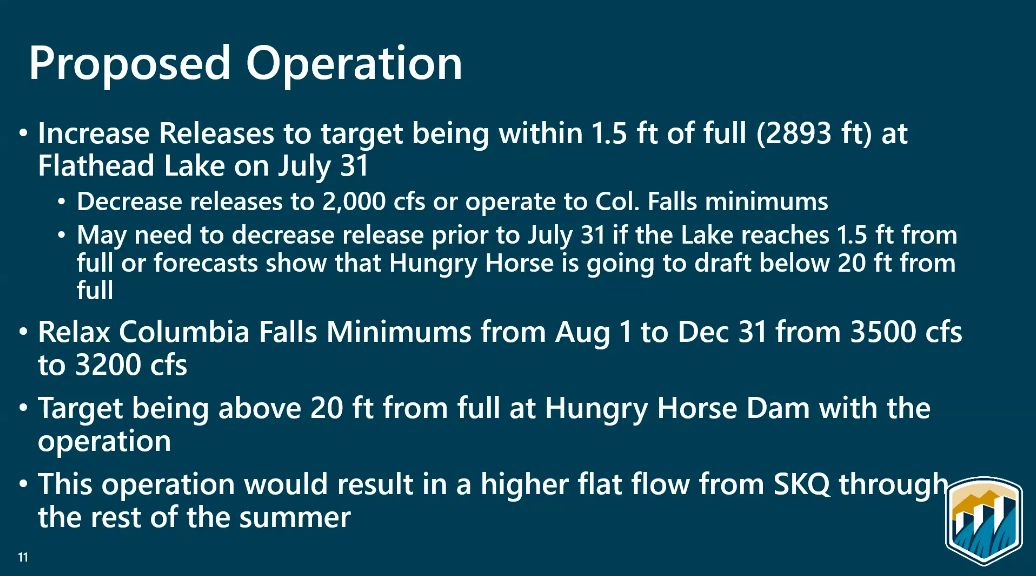Technical Team Rejects Request to Raise Flathead Lake Levels with Hungry Horse Release
Citing environmental concerns, the interagency management team expressed strong objections over the proposed plan, which members said offered minimal relief to lake levels with large ecological costs
By Micah Drew
Despite pleas from elected leaders lobbying on behalf of stakeholders in the region’s recreation and agricultural economy, the Columbia River Technical Management Team (TMT) at a special meeting on July 14 opted against releasing water from Hungry Horse Reservoir to augment Flathead Lake’s historically low surface level. In rejecting the request, members of the TMT cited adverse impacts to the watershed’s ecology, a risk of Hungry Horse levels not recovering by next year if drought conditions persist and federal regulations setting the reservoir’s low-water mark.
Weeks of political pressure to address the region’s drought conditions culminated on July 13 with a formal request by Montana Gov. Greg Gianforte for the interagency task force to consider releases from the reservoir “in an amount practical and compliant with state and federal law and regulations.”
The TMT, made up of representatives from four states, five federal agencies and six tribal nations, prioritizes fish and wildlife above other system benefits, and makes operational recommendations to the action agencies that control federal dams. The Bureau of Reclamation (BOR) operates Hungry Horse Dam.
With the surface of Flathead Lake on Friday measuring 23 inches below its full pool level of 2,893 feet, the technical team’s rejection of Gianforte’s request rankled the state’s elected leaders.

In a statement released after the meeting concluded, western Montana’s Republican U.S. Rep. Ryan Zinke, a former Interior Secretary who has been pressing the federal BoR to “fill the lake,” criticized the decision.
“Let’s be clear, the Commissioner of Reclamation has the authority to make the executive decision and does not need to bow to the unelected bureaucrats at the TMT who care more about fish than people. USBR does not lack authority. The only thing they lack is leadership,” Zinke said in a prepared statement. “It is obvious Congress must use the power of the purse to demand Federal authorities prioritize multiple use to include recreation, economic impact, and public safety.”
At the Friday meeting, the TMT discussed Gianforte’s request at length, despite it not having “the same level of technical detail the TMT asks for and requests,” according to team members.
Michael Freeman, Gianforte’s natural resources advisor, said the state submitted the systems operational request (SOR) to make sure all boxes were checked off to encourage discussions, acknowledging that it lacked the complex technical analysis normally included.
Joel Fenolio, who oversees regional river and reservoir operations for the BOR, presented a proposed operation to increase flows from Hungry Horse reservoir, which he said would raise Flathead Lake to within 1.5 feet of full pool.

That operation was considered the most “extreme option” allowable under the regulations that manage the Pacific Northwest’s major federal dams projects in a way that balances flood control, power generation and for the recovery of several threatened and endangered species. For Hungry Horse specifically, releases from the reservoir are used to augment Flathead River levels throughout the late summer and into the fall to ensure optimal habitat for threatened bull trout populations.

At most, Hungry Horse Reservoir can only be drawn down 20 feet below its full-pool level of 3,560 feet by the end of September, according to Fenolio, with a target of around 12 feet under optimal conditions. Following low water-supply forecasts in May, BOR determined it was likely the reservoir would drop to between 15-18 feet below full-pool levels to supply the main stem of the Flathead River at the required minimum levels.
With only a few feet of flexibility, Fenolio drafted a plan that would double the flow from Hungry Horse into the South Fork Flathead River for the remainder of July, resulting in a potential increase to Flathead Lake of around five inches.
“That’s about the most we could do within the biological opinions and record of decision at this point,” Fenolio said during the conference call.
County commissioners from both Lake and Flathead counties were critical of the plan, saying it did not adequately address their concerns.
Flathead County Commissioner Randy Brodehl said at a minimum the lake needed to come within 14 inches of full pool, and ideally within a foot.
“That would be a difference people are used to dealing with,” Lake County Commissioner Gale Decker said. “What we have now with the two feet is different from anything else we’ve ever experienced in July. The lake is quiet, people aren’t recreating, people have their boats out of the water.”
“We need to come up with possible solutions to get us to the middle of September, and then deal with the ramifications at a later time,” he continued.

Agency representatives ran through myriad concerns of mid-summer flow augmentation, including risks to filling the reservoir during the 2024 water year and adverse effects to river ecology.
Montana’s TMT representative Brian Marotz spent more than three decades working for Montana Fish Wildlife and Parks studying how dam operations affect Montana’s watersheds and resident fish species, and also helped design the operating plan for Hungry Horse Dam.
Marotz said that from a fisheries perspective, the main goal is to avoid major river fluctuations during the “biologically productive summer months,” when juvenile bull trout are most sensitive to a changing environment.
“For years we’ve prided ourselves in successfully achieving not having a double peak in the water flows, and this would essentially be doing that,” he told the TMT. “To lose that extra amount of water volume would have a cascading effect and carry forward into 2024. To me, this is a huge impact that hasn’t been fully vetted here.” Marotz added that, despite being one of the state’s TMT representatives, he had not been involved in any conversations with the governor’s office about the requested release and felt the TMT was unprepared to fully analyze the impacts.
Clint Muhlfeld, a research aquatic ecologist with the U.S. Geological Survey who is not involved with the TMT, told the Beacon that maintaining even discharges to the Flathead River over the summer months is critical for bull trout and the entire interconnected aquatic food web.
According to a 2012 study Muhlfeld authored, an increased streamflow of around 1,765 cubic feet per second (cfs) would lead to a roughly 25% decrease in usable habitat space for bull trout. Similarly, increased summertime discharges significantly impact the life cycle of aquatic insects, a primary food source for native fish, especially threatened bull trout. Muhlfeld said it takes roughly six weeks for aquatic insects to colonize sections of riverbed and reach productive levels, so a rapid change in water levels could shift the entire waterway’s biological clock.
“The worst-case scenario is unnatural flow fluctuations,” Muhlfeld said, pointing out that decades of research went into crafting the plans that currently manage the river system. “A big release would lead to cascading impacts to the entire aquatic ecosystem.”
During the TMT meeting, the proposed action also prompted questions about whether the Seli’š Ksanka Qlispe’ Dam that controls Flathead Lake’s output has an obligation to continually pass water through the impoundment, or if it could legally hoard it, adding further uncertainty to the discussion.
“It sounds like Reclamation could release this water as proposed, but it’s not going to provide the relief to people around Flathead Lake that they need, and on top of that it’ll have a negative biological effect in the Flathead, potentially both above and below Flathead Lake,” said Jonathan Ebel, a TMT representative from Idaho Fish and Game.
When polled about the proposed action, a majority of members, including Marotz, objected to the plan. No members voted in support.

The Bureau of Reclamation will continue to operate Hungry Horse Dam according to its most recent regime coordinated with the TMT in June, which includes releasing water at a rate of 2,000 cfs until the Flathead River requires additional water to hit minimum flow rates.
Brodehl said that while he is “incredibly disappointed” with the decision, the county will continue working with the congressional delegation to seek out every option that could bring relief.
“It’s a tough way to do it, and the elasticity on our timeframe to get anything done has shrunk to almost nothing,” he said. “We are still committed to doing anything we can to support the people of Flathead County.”